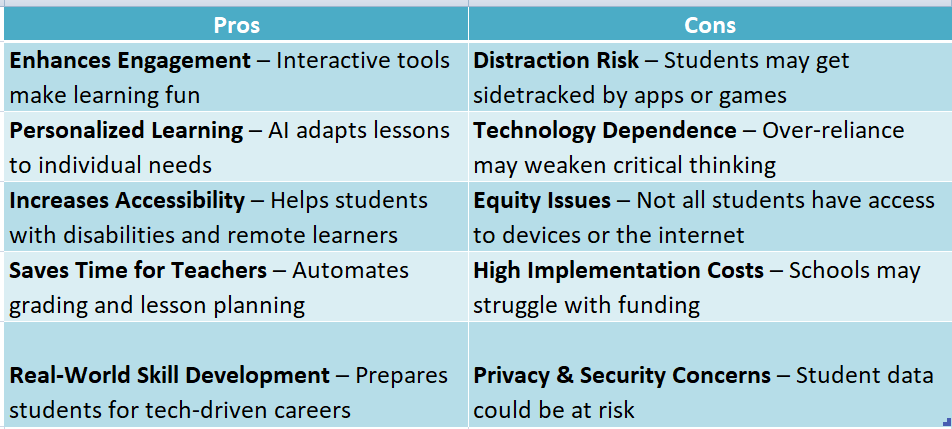
In today’s fast-paced educational landscape, staying updated on the latest in educational technology is crucial for teachers. New teaching technology not only enhances lesson delivery but also significantly boosts student engagement. As educators embrace these innovations, they can create more interactive and personalized learning experiences that cater to diverse student needs.
The Role of AI in Education
AI is transforming classrooms in remarkable ways. Teachers using AI can automate administrative tasks, allowing them to focus more on teaching. Additionally, AI tools can provide personalized learning experiences, adapting to each student’s pace and style.
How Can Students Use AI in School?
Students can leverage AI for various purposes, such as:
- Personalized Learning: Tailored resources based on individual learning paths.
- Research Assistance: AI-driven tools can help students gather information quickly.
- Skill Development: Interactive platforms can enhance critical thinking and problem-solving skills.
By integrating these technologies, educators can foster a more engaging and effective learning environment, ultimately preparing students for a tech-driven future.
Unlock your potential with online degrees—Learn more!
How Virtual Reality is Transforming Classroom Learning
In today’s rapidly evolving educational landscape, it’s essential for teachers to stay informed about the latest in educational technology. Innovations like virtual reality (VR) are transforming classroom experiences, making learning more immersive and engaging. This technology captivates students’ attention and enhances their understanding of complex concepts.
Virtual reality provides a unique platform for experiential learning. By immersing students in virtual environments, teachers can foster deeper connections to the material. Key benefits of using VR in education include:
- Enhanced Engagement: Students are more likely to participate actively when learning through VR.
- Real-World Applications: VR simulates real-life scenarios, helping students apply theoretical knowledge practically.
- Personalized Learning: Teachers can customize VR experiences to meet diverse learning needs, ensuring all students benefit from new teaching technology.
How Can Students Use AI in School?
AI represents another exciting frontier in educational technology. Teachers using AI can streamline administrative tasks, freeing up more time for instruction. Students can utilize AI tools for personalized learning experiences, such as adaptive learning platforms that adjust content based on their progress, enhancing learning and preparing them for a tech-driven future.

The Rise of AI-Powered Tools: Are They the Future of Education?
In today’s fast-paced educational landscape, staying updated with the latest in educational technology is crucial for teachers. With the rise of AI-powered tools, educators are exploring innovative ways to enhance learning experiences. These advancements not only streamline teaching processes but also engage students in unprecedented ways.
Transforming Teaching Methods
AI tools are reshaping how teachers deliver lessons. From personalized learning experiences to automated grading systems, new teaching technology is making classrooms more efficient. Teachers using AI can focus more on student interaction rather than administrative tasks, ultimately enhancing the educational experience.
Empowering Students with AI
So, how can students use AI in school? AI can assist students in various ways, such as providing instant feedback on assignments, offering personalized study plans, and even facilitating collaborative projects. This technology not only supports learning but also prepares students for a tech-driven future.
Gamification in Education: What’s New and How It Works
Gamification in education is revolutionizing classroom dynamics, making learning more engaging and interactive. As teachers adopt new teaching technology, they discover that gamification not only motivates students but also deepens their understanding of complex subjects. By integrating game elements into lessons, educators foster collaboration and critical thinking.
What is Gamification?
Gamification applies game design elements in educational contexts, encouraging active student participation and improving information retention. Key components include:
- Points and Rewards: Students earn points for completing tasks, redeemable for rewards.
- Leaderboards: Friendly competition inspires students to improve.
- Challenges and Levels: Tasks are structured in levels, allowing personalized progression.
Benefits of Gamification for Teachers
Teachers utilizing AI and gamification can monitor student progress in real-time, customizing lessons to individual needs. Gamification also aids in:
- Enhancing Engagement: Learning becomes more appealing when it resembles a game.
- Fostering Collaboration: Group challenges enhance teamwork and communication skills.
- Encouraging Persistence: Game mechanics help students tackle challenges, building resilience in their educational journey.
Blended Learning Models: Combining Traditional and Digital Approaches
In today’s fast-paced educational landscape, staying updated on the latest in educational technology is crucial for teachers. Blended learning models are at the forefront, merging traditional teaching methods with innovative digital tools. This approach not only enhances student engagement but also prepares them for a tech-driven world.
Benefits of Blended Learning
- Flexibility: Students can learn at their own pace, balancing in-class instruction with online resources.
- Personalization: Teachers can tailor lessons to meet individual student needs, utilizing new teaching technology effectively.
- Enhanced Collaboration: Digital platforms foster collaboration among students, encouraging teamwork and communication skills.
How Can Students Use AI in School?
AI tools are becoming increasingly popular in classrooms. For instance, students can leverage AI for personalized learning experiences, accessing resources that cater to their unique learning styles. Teachers using AI can analyze student performance data, allowing for targeted interventions and improved outcomes. This integration of AI not only enriches the learning experience but also prepares students for future challenges.
What Role Does Data Analytics Play in Educational Technology?
In today’s fast-paced educational landscape, understanding the latest in educational technology is crucial for teachers. With the rise of new teaching technology, educators can enhance learning experiences and better meet the needs of their students. One significant advancement is the integration of data analytics, which plays a pivotal role in shaping educational practices.
Data analytics helps teachers make informed decisions by providing insights into student performance and engagement. By analyzing data, educators can identify trends and tailor their teaching strategies accordingly. This not only supports personalized learning but also empowers teachers using AI to predict student outcomes and intervene when necessary.
Benefits of Data Analytics in Education
- Enhanced Learning Outcomes: Data-driven insights help in customizing lessons to fit individual student needs.
- Improved Resource Allocation: Schools can optimize their resources based on data trends.
- Informed Decision Making: Teachers can leverage analytics to refine their teaching methods and improve classroom dynamics.
As we explore how can students use AI in school, it becomes clear that data analytics is a key component in maximizing the potential of these technologies.
Unlock your potential with online degrees—Learn more!
The Importance of Professional Development in Adopting New Teaching Technology
The rapid evolution of educational technology has made it essential for teachers to stay updated. Embracing new teaching technology not only enhances classroom engagement but also prepares students for a tech-driven future. Professional development plays a crucial role in helping educators effectively integrate these tools into their teaching practices.
Benefits of Continuous Learning
- Enhanced Skills: Teachers using AI can refine their instructional strategies, making learning more personalized.
- Increased Confidence: Familiarity with new tools boosts teachers’ confidence in the classroom.
- Student Engagement: Innovative technology keeps students interested and motivated to learn.
How Can Students Use AI in School?
- Personalized Learning: AI can tailor educational experiences to meet individual student needs.
- Efficient Research: Students can leverage AI tools for quick information retrieval and analysis.
- Collaboration: AI fosters collaborative projects, enhancing teamwork skills among students.
How Can CollegeAndTuition.com Support Teachers in Integrating Tech into Their Classrooms?
In today’s fast-paced educational landscape, staying updated with the latest in educational technology is crucial for teachers. New teaching technology not only enhances the learning experience but also equips educators with tools to engage students effectively. As classrooms evolve, integrating these technologies becomes essential for fostering a dynamic learning environment.
Personalized Training and Resources
At CollegeAndTuition.com, we offer tailored training sessions that help teachers understand how to implement new teaching technology seamlessly. This includes workshops on using AI tools effectively, ensuring educators feel confident in their tech skills.
Access to Innovative Tools
We provide access to cutting-edge resources that demonstrate how students can use AI in school. From interactive learning platforms to AI-driven assessment tools, our offerings empower teachers to enhance their curriculum and engage students in meaningful ways.
Future Trends: What’s Next for Educational Technology in Schools?
In the ever-evolving landscape of education, staying updated with the latest in educational technology is crucial for teachers. New teaching technology not only enhances learning experiences but also prepares students for a tech-driven world. As we look ahead, several trends are shaping the future of educational technology in schools.
AI Integration in Classrooms
Teachers using AI are finding innovative ways to personalize learning. For instance, AI can analyze student performance and suggest tailored resources, making education more effective. How can students use AI in school? They can leverage AI tools for research, writing assistance, and even coding, fostering a more interactive learning environment.
Collaborative Learning Platforms
Another trend is the rise of collaborative learning platforms. These tools enable students to work together, regardless of location, enhancing teamwork skills. Features include:
- Real-time document editing
- Video conferencing capabilities
- Shared project boards By embracing these new teaching technologies, educators can create dynamic classrooms that engage students and prepare them for future challenges.
Unlock your potential with online degrees—Learn more!
FAQs
-
What is teaching technology?
Teaching technology refers to digital tools, software, and devices that enhance the learning experience, improve engagement, and support teachers in delivering effective lessons. -
Why is technology important in modern education?
Technology enhances interactive learning, provides personalized education, enables remote learning, and makes lessons more engaging through multimedia content. -
What are some examples of new teaching technologies?
Some popular tools include smartboards, AI-powered learning platforms, virtual reality (VR), augmented reality (AR), learning management systems (LMS), and online collaboration tools. -
How has AI changed teaching and learning?
AI helps in automated grading, personalized learning, chatbots for student support, and adaptive learning platforms that adjust content based on student progress. -
What is a Learning Management System (LMS)?
An LMS is a software platform (like Google Classroom, Moodle, or Blackboard) that helps teachers manage course materials, track student progress, and facilitate online learning.





